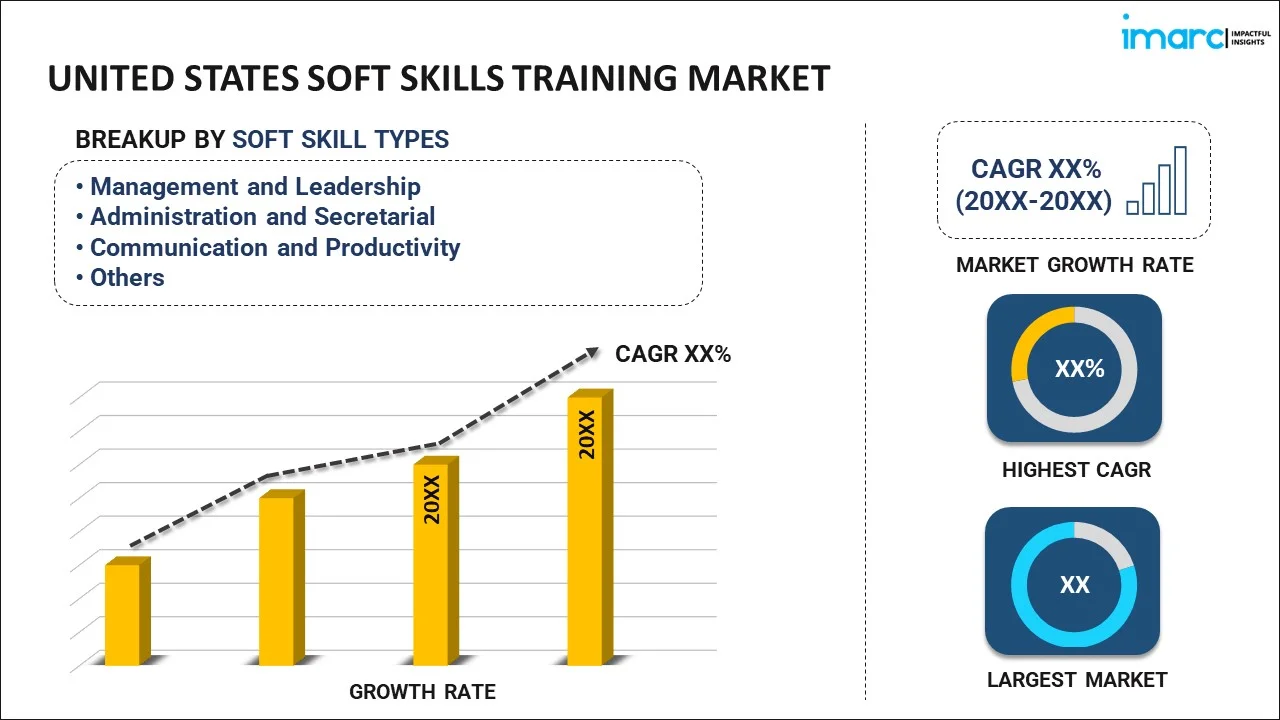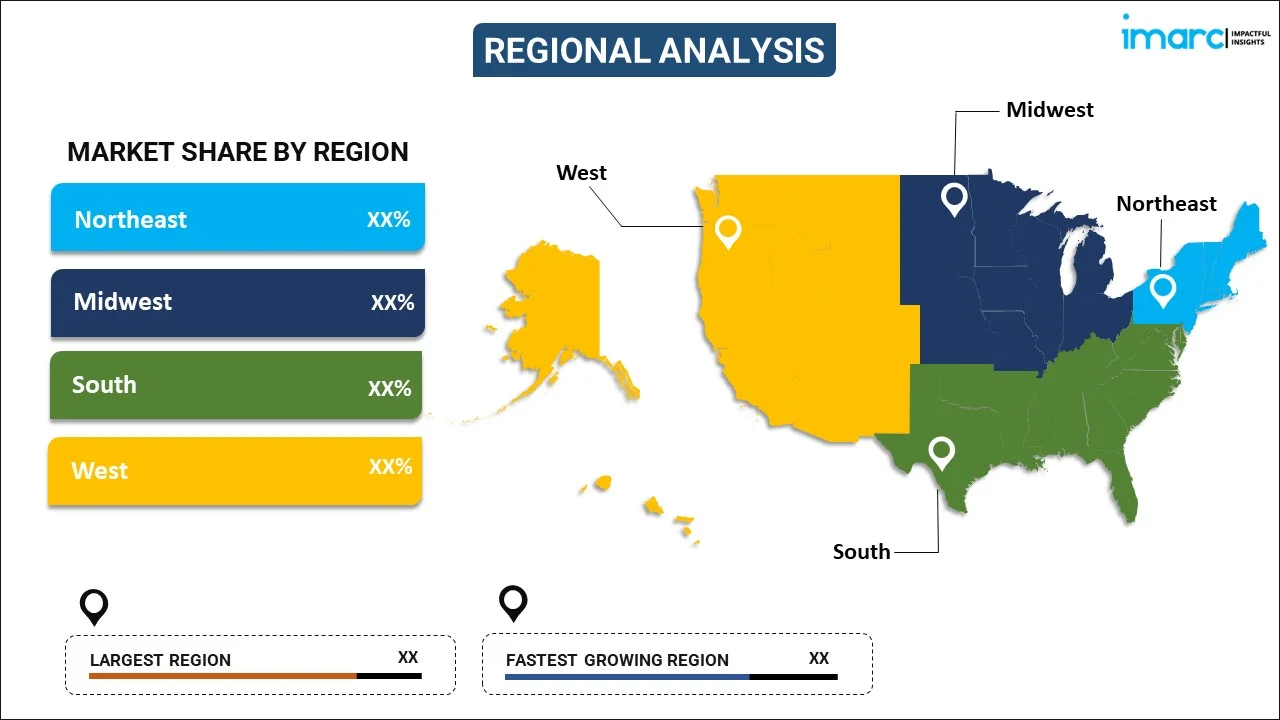
United States Soft Skills Training Market Report by Soft Skill Type (Management and Leadership, Administration and Secretarial, Communication and Productivity, Personal Development, Teamwork, and Others), Channel Provider (Corporate/ Enterprise, Academic/ Education, Government), Sourcing (In-house, Outsourced), Delivery Mode (Online, Offline), End Use Industry (BFSI, Hospitality, Healthcare, Retail, Media and Entertainment, and Others), and Region 2025-2033
Market Overview:
The United States soft skills training market size reached USD 22.8 Billion in 2024. Looking forward, IMARC Group expects the market to reach USD 39.1 Billion by 2033, exhibiting a growth rate (CAGR) of 5.87% during 2025-2033.
|
Report Attribute
|
Key Statistics
|
|---|---|
|
Base Year
|
2024 |
|
Forecast Years
|
2025-2033 |
|
Historical Years
|
2019-2024
|
| Market Size in 2024 | USD 22.8 Billion |
| Market Forecast in 2033 | USD 39.1 Billion |
| Market Growth Rate 2025-2033 | 5.87% |
Soft skills are a combination of communication skills, personal attributes, and social and emotional intelligence. Individuals undertake professional soft skills training to communicate efficiently and manage relationships in a business environment. It also enables them to improve critical thinking and creativity, enhance cognitive flexibility, and develop conflict resolution and negotiating skills. As compared to hard skills, soft skills training is beneficial in improving customer service, employee retention, increasing job satisfaction and overall work productivity.
The increasing focus on the holistic development of employees in the corporate sector is majorly driving the soft skills training market in the United States. In line with this, the incorporation of such training programs in the academia as a part of university curriculum to create lucrative professional opportunities is further contributing to the market growth. Additionally, the large-scale integration of these platforms with advanced technologies, such as artificial intelligence (AI) and virtual reality (VR), is acting as a growth-inducing factor. Apart from this, rising expenditure on acquiring new skills through digital learning, is creating a positive outlook for the market in the country.
Key Market Segmentation:
IMARC Group provides an analysis of the key trends in each sub-segment of the United States soft skills training market report, along with forecasts at the country and regional level from 2025-2033. Our report has categorized the market based on soft skill type, channel provider, sourcing, delivery mode and end use industry.
Breakup by Soft Skill Type:

- Management and Leadership
- Administration and Secretarial
- Communication and Productivity
- Personal Development
- Teamwork
- Others
Breakup by Channel Provider:
- Corporate/ Enterprise
- Academic/ Education
- Government
Breakup by Sourcing:
- In-house
- Outsourced
Breakup by Delivery Mode:
- Online
- Offline
Breakup by End Use Industry:
- BFSI
- Hospitality
- Healthcare
- Retail
- Media and Entertainment
- Others
Breakup by Region:

- Northeast
- Midwest
- South
- West
Competitive Landscape:
The competitive landscape of the industry has also been examined along with the profiles of the key players.
Report Coverage:
| Report Features | Details |
|---|---|
| Base Year of the Analysis | 2024 |
| Historical Period | 2019-2024 |
| Forecast Period | 2025-2033 |
| Units | Billion USD |
| Segment Coverage | Soft Skill Type, Channel Provider, Sourcing, Delivery Mode, End Use Industry, Region |
| Region Covered | Northeast, Midwest, South, West |
| Customization Scope | 10% Free Customization |
| Post-Sale Analyst Support | 10-12 Weeks |
| Delivery Format | PDF and Excel through Email (We can also provide the editable version of the report in PPT/Word format on special request) |
Key Questions Answered in This Report:
- How has the United States soft skills training market performed so far and how will it perform in the coming years?
- What has been the impact of COVID-19 on the United States soft skills training market?
- What are the key regional markets?
- What is the breakup of the market based on the soft skill type?
- What is the breakup of the market based on the channel provider?
- What is the breakup of the market based on the sourcing?
- What is the breakup of the market based on the delivery mode?
- What is the breakup of the market based on the end use industry?
- What are the various stages in the value chain of the industry?
- What are the key driving factors and challenges in the industry?
- What is the structure of the United States soft skills training market and who are the key players?
- What is the degree of competition in the industry?
Need more help?
- Speak to our experienced analysts for insights on the current market scenarios.
- Include additional segments and countries to customize the report as per your requirement.
- Gain an unparalleled competitive advantage in your domain by understanding how to utilize the report and positively impacting your operations and revenue.
- For further assistance, please connect with our analysts.
 Inquire Before Buying
Inquire Before Buying
 Speak to an Analyst
Speak to an Analyst
 Request Brochure
Request Brochure
 Request Customization
Request Customization




.webp)




.webp)












